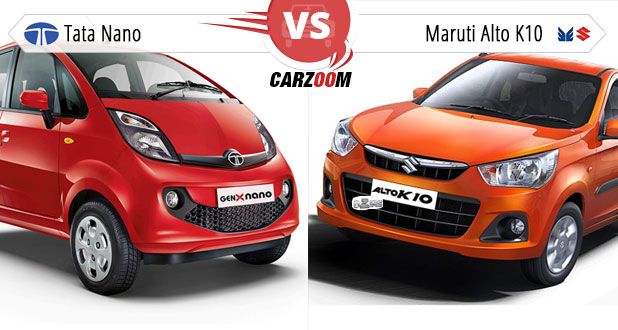
AMT has become quite popular in Indian car market now and the credit goes to Maruti Suzuki as they launched the first AMT equipped car in India, the Celerio hatchback at 2014 auto Expo followed by Alto K10. In 2014 Tata joined the bandwagon with Zest compact sedan and has now launched Nano with AMT aka GenX Nano with easy shift. With the launch, GenX Nano is now most affordable Automatic car that you can buy in India. Earlier automatic gearbox is available only on expensive vehicles or luxury segments but nowadays one can even buy a small hatchback with Automatic transmission like Celerio, Alto K10 and now new Nano.
Since there are two vehicles that use automated manual transmission and both of them is affordable Automatic available in the country we decided to pitch both the cars against to find out which one is superior.
Price:
Tata Nano AMT is available in two trims- XMA which is priced at Rs. 2.69 lakh while the top XTA variant cost at Rs. 2.89 lakh. Maruti Suzuki Alto K10 AMT comes at the price tag of Rs. 3.95 lakh which is around 1 lakh more than the Nano’s XTA and 1.26 lakh more than the XMA variant. Tata Nano clearly has a price advantage here.
Engine and Performance:
Both the cars are available in petrol engine only, Maruti Alto K10 has upper hand here over Nano as it comes with 1.0L K-series engine that develops 67bhp power and 90Nm of torque while GenX is powered by the same 0.6L twin cylinder unit that makes 37bhp power and 51Nm of torque. Transmission option includes 5-speed AMT gearbox on both the cars but Alto AGS is slightly sleek than Nano’s easy shift.
Alto is way faster than Nano, Alto can make 0-100 sprint in 15 seconds with top speed limited to 160km/hr while Nano takes 25 seconds to reach 100 km mark barrier with 110km/hr as limited speed. NVH levels have improved in both the cars but slight vibration is evident when you pass 90km mark.
In fuel efficiency segment, its Alto K10 again taking the Nano down with 24.07 KMPL ARAI certified mileage as compared to Nano’s 21.9 KMPL. During the latest update Tata has increased the fuel tank capacity of Nano from 15 liters to 24 liters but still falls short of Alto’s 35 litre fuel tank.
In terms of performance, both the cars are city cruisers but underperform when it comes to highway throttle. The ride quality of Nano is good keeping in mind its tiny tyres and behaves in dignified manner under >100 km speed. On the other hand, Alto K10 looks far more composed, its AMT takes less time to make up shift and downshift, provides better handling than Nano.
In braking performance, Alto K10 performs better as it is equipped with ventilated disc at front and drum at rear while Nano gets drums at all four. When it comes to absorbing potholes both the cars feels out of their comfort zone on bad roads, but comparing both the cars Alto’s suspension responds in well behaved and silent manner.
Space and Dimensions:
Tata Nano has a tall boy design which makes ingress and egress easier as compared to Alto K10. On paper Alto is larger than Nano in terms of length and larger wheelbase but Nano hit backs with better width and height. At rear bench, Nano offers better legroom, shoulder and headroom space than Alto K10’s cramped and short rear bench.
| Criteria | New Alto K10 | Tata GenX Nano |
| Length | 3545mm | 3099mm |
| Width | 1490mm | 1495mm |
| Height | 1475mm | 1652mm |
| Boot Space | 177 liters | 94/110 liters |
| Ground Clearance | 160mm | 180mm |
| Wheelbase | 2360mm | 2230mm |
The GenX Nano has the best in class ground clearance while the cargo volume of Alto K10 is almost double.
Exterior and Interior:
Tata has updated the new Nano with array of cosmetic changes such as smoked headlamps, new infinity grille with rounded fog lamps, black strip on the front, revised rear side with different spoiler and bumper. On the other hand, Alto K10 looks more premium and flaunts aggressive front fascia and sharper rear side with more freshness on offer.
Maruti has also updated Alto K10 last year with new 3D curve bonnet, thick chrome strip, and big swept headlamps. Alto K10 rear side has mature design than Nano thanks to redesigned tail light units similar to Celerio and chrome line at the bottom of boot lid. Alto K10 is almost a lakh costlier than Nano but still misses out on Fog lamps even on the top AMT variant. In terms of design both the cars are average lookers and frankly speaking styling doesn’t play that much role between the two as it’s all about the budget and performance.
On the Inside, Both the cars are equipped with AC, music system, front power windows, central locking as standard but there are certain features such as bluetooth connectivity, 12V power socket, number of speakers, keyless entry which are present on Nano but absent on Alto K10. However, Alto k10 offers three point seat belts for the front and seat belts for the rear passengers while Nano misses out on rear belts only offer lap seat belts. Overall feel and quality is a little bit better in Alto K10 but that doesn’t mean Nano has cheap quality plastics or material and we must admit that with every launch Tata has been significantly improving in interior and feature department.
Safety:
In this segment both the cars are poor as Nano and Alto k10 do not offer Airbag, ABS though driver side airbag is available in VXI (O) trim of Alto K10. Both the cars scored zero in NCAP crash tests thus neither of the car is safe.
Verdict:
Maruti Suzuki Alto K10 outperforms Nano in various departments such as fuel efficiency, performance, corner carving, boot space, quality, interior design and after sale service. Nano, on the other hand outscores its rival in rear bench space, some particular features that makes it value for money car. Tata Nano is almost a lakh lesser than the Alto, it’s easy to drive in city but Alto K10 offers better refinement level than Nano and turns out to be a complete car.




























